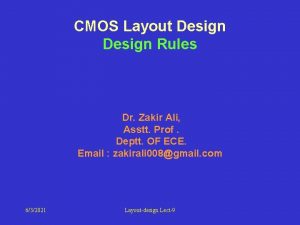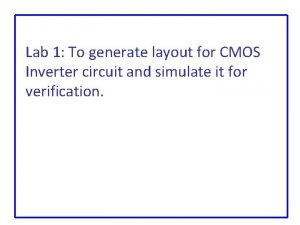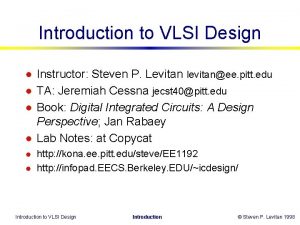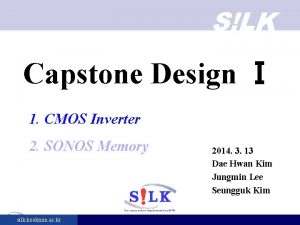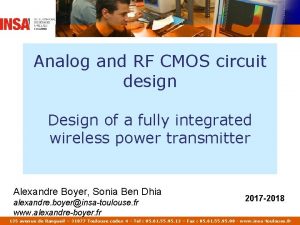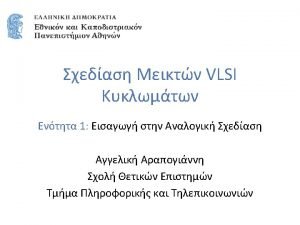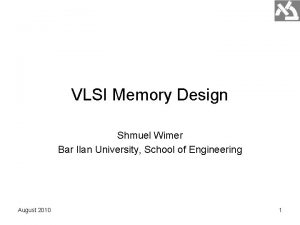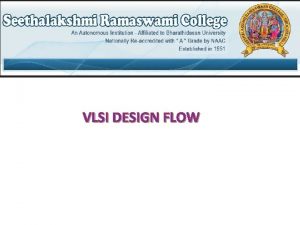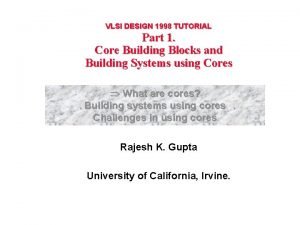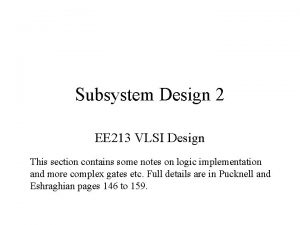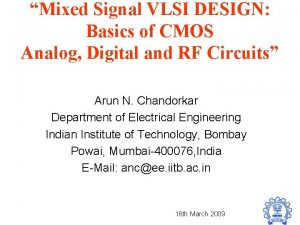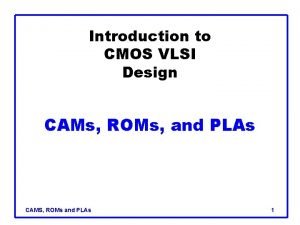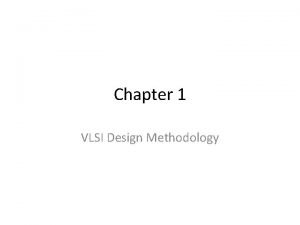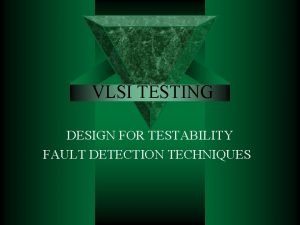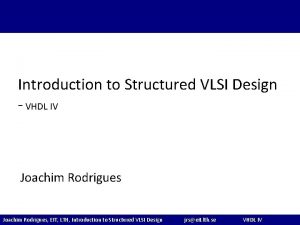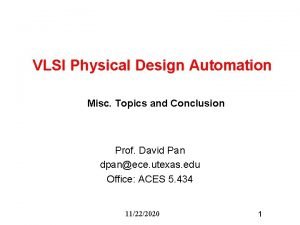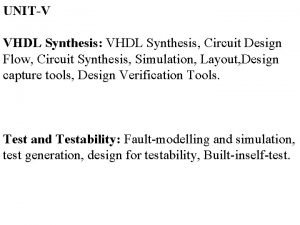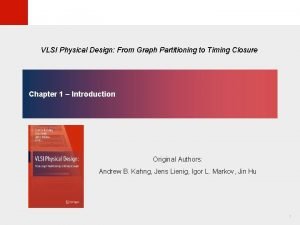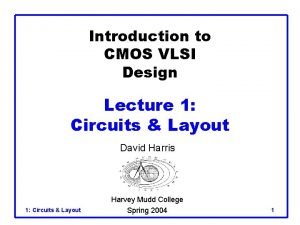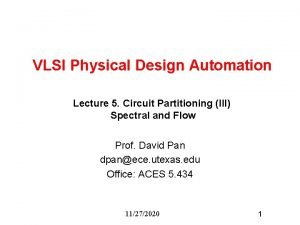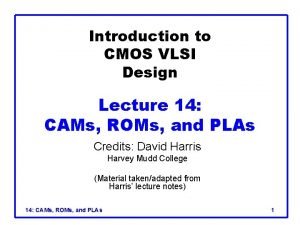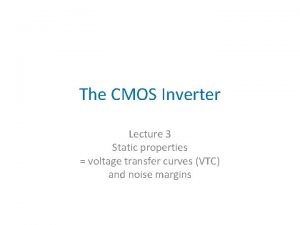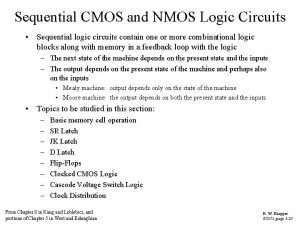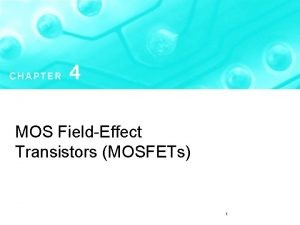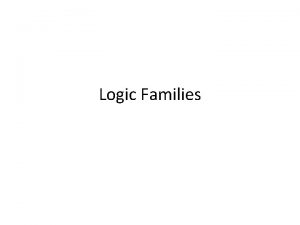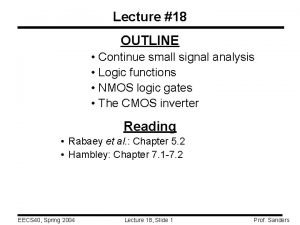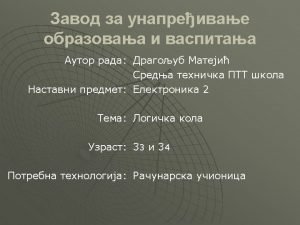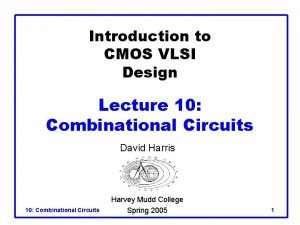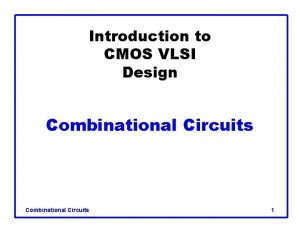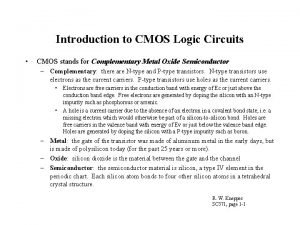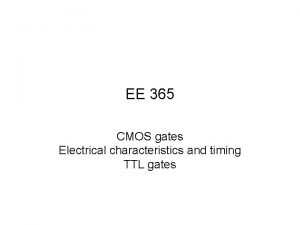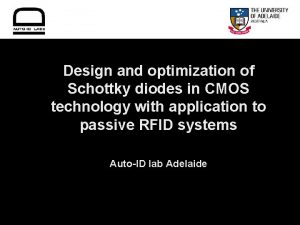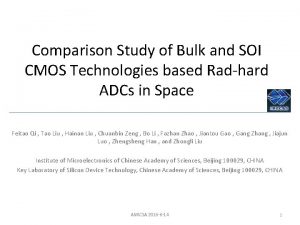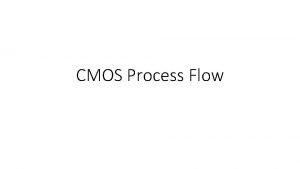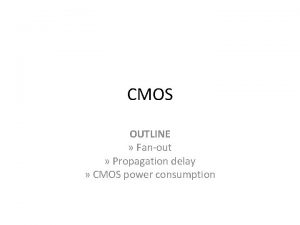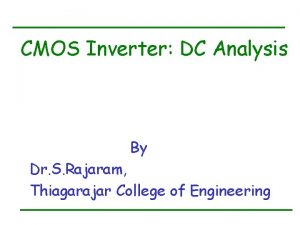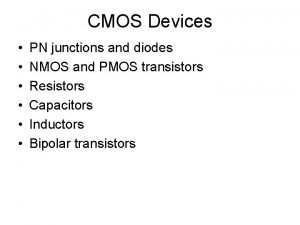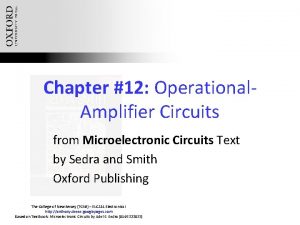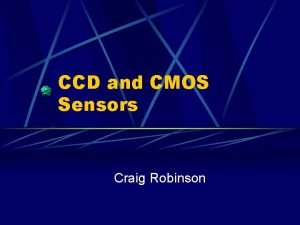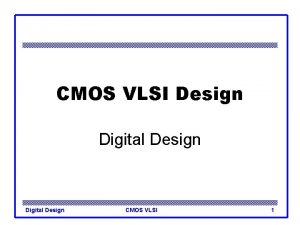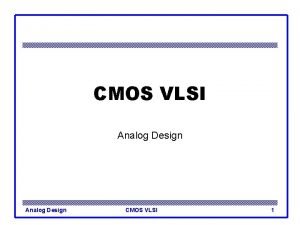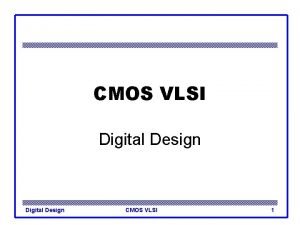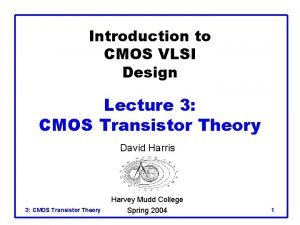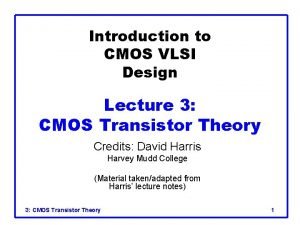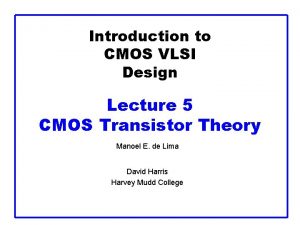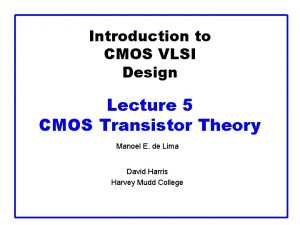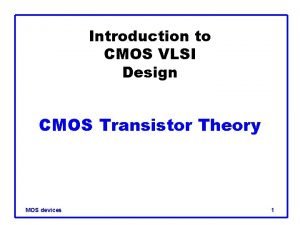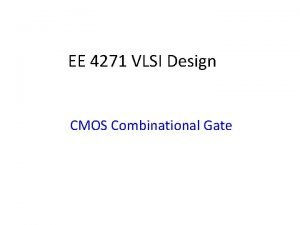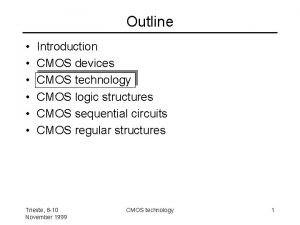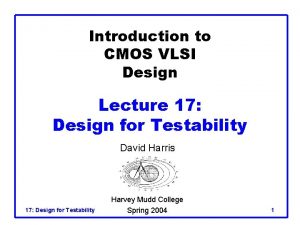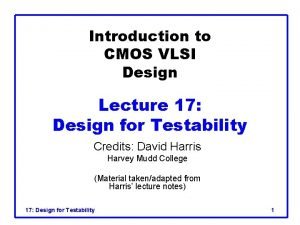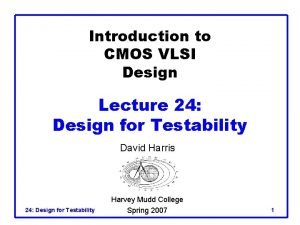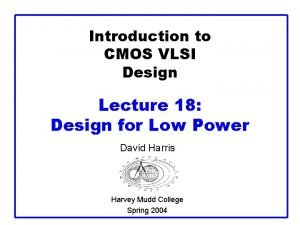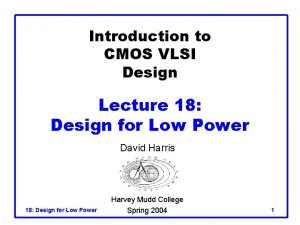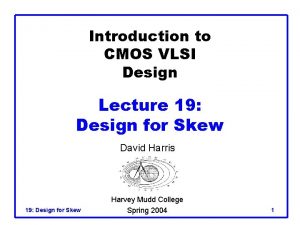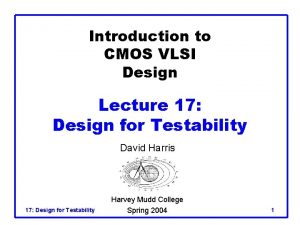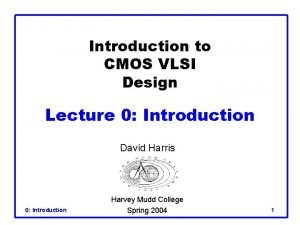Introduction to CMOS VLSI Design Lecture 0 Introduction






















































- Slides: 54

Introduction to CMOS VLSI Design Lecture 0: Introduction Credits: David Harris Harvey Mudd College (Material taken/adapted from Harris’ lecture notes) 0: Introduction 1

Outline q Course Information – Logistics – Grading – Syllabus – Course Overview q Introduction to VLSI – MOS transistors – CMOS logic gates – Fabrication process: overview 0: Introduction CMOS VLSI Design 2

Course Information (1) Time and Place – Tue/Thu 3: 30 -4: 45 pm, SN 325 Instructor – Montek Singh – montek@cs. unc. edu (not singh@cs!) – SN 245, 962 -1832 – Office hours: walk in most afternoons Course Web Page – http: //www. cs. unc. edu/~montek 0: Introduction CMOS VLSI Design 3

Course Information (2) Prerequisites – Computer organization (COMP 120), and digital logic (COMP 160, PHYS 102), or equivalent – I assume you know the following topics • Boolean algebra, logic gates, etc. • Undergraduate physics: Ohm’s law, resistors, capacitors, etc. • Undergraduate math: calculus 0: Introduction CMOS VLSI Design 4

Course Information (3) q Textbook – Weste and Harris. CMOS VLSI Design (3 rd edition) • Addison Wesley • ISBN: 0 -321 -14901 -7 • Available at amazon. com. 0: Introduction CMOS VLSI Design 5

Course Information (4) q Grading – 40% major project – 25% minor project (in lieu of mid-term exam) – 25% assignments – 10% class participation 0: Introduction CMOS VLSI Design 6

Course Information (5) q Topics – Introduction to CMOS circuits – MOS transistor theory, processing technology – CMOS circuit and logic design – System design methods – High-level languages for VLSI design – Case studies, CAD tools, etc. 0: Introduction CMOS VLSI Design 7

Introduction q Integrated circuits: many transistors on one chip. q Very Large Scale Integration (VLSI): very many q Complementary Metal Oxide Semiconductor – Fast, cheap, low power transistors q Today: How to build your own simple CMOS chip – CMOS transistors – Building logic gates from transistors – Transistor layout and fabrication q Rest of the course: How to build a good CMOS chip 0: Introduction CMOS VLSI Design 8

Silicon Lattice q Transistors are built on a silicon substrate q Silicon is a Group IV material q Forms crystal lattice with bonds to four neighbors 0: Introduction CMOS VLSI Design 9

Dopants q q q Silicon is a semiconductor Pure silicon has no free carriers and conducts poorly Adding dopants increases the conductivity Group V: extra electron (n-type) Group III: missing electron, called hole (p-type) 0: Introduction CMOS VLSI Design 10

p-n Junctions q A junction between p-type and n-type semiconductor forms a diode. q Current flows only in one direction 0: Introduction CMOS VLSI Design 11

n. MOS Transistor q Four terminals: gate, source, drain, body q Gate – oxide – body stack looks like a capacitor – Gate and body are conductors – Si. O 2 (oxide) is a very good insulator – Called metal – oxide – semiconductor (MOS) capacitor – Even though gate is no longer made of metal 0: Introduction CMOS VLSI Design 12

n. MOS Operation q Body is commonly tied to ground (0 V) q When the gate is at a low voltage: – P-type body is at low voltage – Source-body and drain-body diodes are OFF – No current flows, transistor is OFF 0: Introduction CMOS VLSI Design 13

n. MOS Operation Cont. q When the gate is at a high voltage: – Positive charge on gate of MOS capacitor – Negative charge attracted to body – Inverts a channel under gate to n-type – Now current can flow through n-type silicon from source through channel to drain, transistor is ON 0: Introduction CMOS VLSI Design 14

p. MOS Transistor q Similar, but doping and voltages reversed – Body tied to high voltage (VDD) – Gate low: transistor ON – Gate high: transistor OFF – Bubble indicates inverted behavior 0: Introduction CMOS VLSI Design 15

Power Supply Voltage q GND = 0 V q In 1980’s, VDD = 5 V q VDD has decreased in modern processes – High VDD would damage modern tiny transistors – Lower VDD saves power q VDD = 3. 3, 2. 5, 1. 8, 1. 5, 1. 2, 1. 0, … 0: Introduction CMOS VLSI Design 16

Transistors as Switches q We can view MOS transistors as electrically controlled switches q Voltage at gate controls path from source to drain 0: Introduction CMOS VLSI Design 17

CMOS Inverter A Y 0 1 0: Introduction CMOS VLSI Design 18

CMOS Inverter A Y 0 1 0 0: Introduction CMOS VLSI Design 19

CMOS Inverter A Y 0 1 1 0 0: Introduction CMOS VLSI Design 20

CMOS NAND Gate A B 0 0 0 1 1 0: Introduction Y CMOS VLSI Design 21

CMOS NAND Gate A B Y 0 0 1 1 0: Introduction CMOS VLSI Design 22

CMOS NAND Gate A B Y 0 0 1 1 1 0: Introduction CMOS VLSI Design 23

CMOS NAND Gate A B Y 0 0 1 1 1 0: Introduction CMOS VLSI Design 24

CMOS NAND Gate A B Y 0 0 1 1 1 0 0: Introduction CMOS VLSI Design 25

CMOS NOR Gate A B Y 0 0 1 0 1 0 0 1 1 0 0: Introduction CMOS VLSI Design 26

3 -input NAND Gate q Y pulls low if ALL inputs are 1 q Y pulls high if ANY input is 0 0: Introduction CMOS VLSI Design 27

3 -input NAND Gate q Y pulls low if ALL inputs are 1 q Y pulls high if ANY input is 0 0: Introduction CMOS VLSI Design 28

CMOS Fabrication q CMOS transistors are fabricated on silicon wafer q Lithography process similar to printing press q On each step, different materials are deposited or etched q Easiest to understand by viewing both top and crosssection of wafer in a simplified manufacturing process 0: Introduction CMOS VLSI Design 29

Inverter Cross-section q Typically use p-type substrate for n. MOS transistors q Requires n-well for body of p. MOS transistors 0: Introduction CMOS VLSI Design 30

Well and Substrate Taps q Substrate must be tied to GND and n-well to VDD q Metal to lightly-doped semiconductor forms poor connection (used for Schottky Diode) q Use heavily doped well and substrate contacts / taps 0: Introduction CMOS VLSI Design 31

Inverter Mask Set q Transistors and wires are defined by masks q Cross-section taken along dashed line 0: Introduction CMOS VLSI Design 32

Detailed Mask Views q Six masks – n-well – Polysilicon – n+ diffusion – p+ diffusion – Contact – Metal 0: Introduction CMOS VLSI Design 33

Fabrication Steps q Start with blank wafer q Build inverter from the bottom up q First step will be to form the n-well – Cover wafer with protective layer of Si. O 2 (oxide) – Remove layer where n-well should be built – Implant or diffuse n dopants into exposed wafer – Strip off Si. O 2 0: Introduction CMOS VLSI Design 34

Oxidation q Grow Si. O 2 on top of Si wafer – 900 – 1200 C with H 2 O or O 2 in oxidation furnace 0: Introduction CMOS VLSI Design 35

Photoresist q Spin on photoresist – Photoresist is a light-sensitive organic polymer – Softens where exposed to light 0: Introduction CMOS VLSI Design 36

Lithography q Expose photoresist through n-well mask q Strip off exposed photoresist 0: Introduction CMOS VLSI Design 37

Etch q Etch oxide with hydrofluoric acid (HF) – Seeps through skin and eats bone; nasty stuff!!! q Only attacks oxide where resist has been exposed 0: Introduction CMOS VLSI Design 38

Strip Photoresist q Strip off remaining photoresist – Use mixture of acids called piranah etch q Necessary so resist doesn’t melt in next step 0: Introduction CMOS VLSI Design 39

n-well q n-well is formed with diffusion or ion implantation q Diffusion – Place wafer in furnace with arsenic gas – Heat until As atoms diffuse into exposed Si q Ion Implanatation – Blast wafer with beam of As ions – Ions blocked by Si. O 2, only enter exposed Si 0: Introduction CMOS VLSI Design 40

Strip Oxide q Strip off the remaining oxide using HF q Back to bare wafer with n-well q Subsequent steps involve similar series of steps 0: Introduction CMOS VLSI Design 41

Polysilicon q Deposit very thin layer of gate oxide – < 20 Å (6 -7 atomic layers) q Chemical Vapor Deposition (CVD) of silicon layer – Place wafer in furnace with Silane gas (Si. H 4) – Forms many small crystals called polysilicon – Heavily doped to be good conductor 0: Introduction CMOS VLSI Design 42

Polysilicon Patterning q Use same lithography process to pattern polysilicon 0: Introduction CMOS VLSI Design 43

N-diffusion q Use oxide and masking to expose where n+ dopants should be diffused or implanted q N-diffusion forms n. MOS source, drain, and n-well contact 0: Introduction CMOS VLSI Design 44

N-diffusion (cont. ) q Pattern oxide and form n+ regions 0: Introduction CMOS VLSI Design 45

N-diffusion (cont. ) q Historically dopants were diffused q Usually ion implantation today q But regions are still called diffusion 0: Introduction CMOS VLSI Design 46

N-diffusion (cont. ) q Strip off oxide to complete patterning step 0: Introduction CMOS VLSI Design 47

P-Diffusion q Similar set of steps form p+ diffusion regions for p. MOS source and drain and substrate contact 0: Introduction CMOS VLSI Design 48

Contacts q Now we need to wire together the devices q Cover chip with thick field oxide q Etch oxide where contact cuts are needed 0: Introduction CMOS VLSI Design 49

Metalization q Sputter on aluminum over whole wafer q Pattern to remove excess metal, leaving wires 0: Introduction CMOS VLSI Design 50

Layout q Chips are specified with set of masks q Minimum dimensions of masks determine transistor size (and hence speed, cost, and power) q Feature size f = distance between source and drain – Set by minimum width of polysilicon q Feature size improves 30% every 3 years or so q Normalize for feature size when describing design rules q Express rules in terms of l = f/2 – E. g. l = 0. 3 mm in 0. 6 mm process 0: Introduction CMOS VLSI Design 51

Simplified Design Rules q Conservative rules to get you started 0: Introduction CMOS VLSI Design 52

Inverter Layout q Transistor dimensions specified as Width / Length – Minimum size is 4 l / 2 l, sometimes called 1 unit – In f = 0. 6 mm process, this is 1. 2 mm wide, 0. 6 mm long 0: Introduction CMOS VLSI Design 53

Summary q q MOS Transistors are stack of gate, oxide, silicon Can be viewed as electrically controlled switches Build logic gates out of switches Draw masks to specify layout of transistors q Now you know everything necessary to start designing schematics and layout for a simple chip! 0: Introduction CMOS VLSI Design 54
 Cmos vlsi design lecture notes
Cmos vlsi design lecture notes Layout design rules in cmos vlsi
Layout design rules in cmos vlsi Microwind cmos inverter
Microwind cmos inverter Introduction to vlsi design
Introduction to vlsi design 01:640:244 lecture notes - lecture 15: plat, idah, farad
01:640:244 lecture notes - lecture 15: plat, idah, farad Cmos inverter design
Cmos inverter design Complex cmos logic gates
Complex cmos logic gates Device modeling for analog and rf cmos circuit design
Device modeling for analog and rf cmos circuit design Analog and digital difference
Analog and digital difference Memory design in vlsi
Memory design in vlsi Y chart in vlsi design
Y chart in vlsi design Biucache
Biucache Subsystem design in vlsi
Subsystem design in vlsi Mixed signal vlsi design
Mixed signal vlsi design Vlsi
Vlsi Vlsi design tutorial
Vlsi design tutorial Y chart in vlsi
Y chart in vlsi Regularity in vlsi design is defined as
Regularity in vlsi design is defined as Ad hoc testable design techniques in vlsi
Ad hoc testable design techniques in vlsi Structured vlsi design
Structured vlsi design Vlsi conclusion
Vlsi conclusion Vlsi design styles
Vlsi design styles Vhdl design flow
Vhdl design flow Vlsi design flow
Vlsi design flow Mux stick diagram
Mux stick diagram åq
åq Rom design in vlsi
Rom design in vlsi Eurocode 2 lap length table
Eurocode 2 lap length table Elemen urban design
Elemen urban design Elements and principles of design ppt
Elements and principles of design ppt Lecture hall acoustics
Lecture hall acoustics Game design lecture
Game design lecture Computer aided drug design lecture notes
Computer aided drug design lecture notes Introduction to biochemistry lecture notes
Introduction to biochemistry lecture notes Introduction to psychology lecture
Introduction to psychology lecture Introduction to algorithms lecture notes
Introduction to algorithms lecture notes Cmos inverter characteristics
Cmos inverter characteristics Nmos
Nmos Cmos cross section
Cmos cross section Characteristics of logic family
Characteristics of logic family Small signal model of cmos inverter
Small signal model of cmos inverter Rtl inverter
Rtl inverter Skewed gates
Skewed gates Skewed gates
Skewed gates Cmos stand for
Cmos stand for Pmos transistor
Pmos transistor Schottky diode layout
Schottky diode layout Bulk cmos
Bulk cmos Cmos process flow
Cmos process flow Fan in and fan out in cmos
Fan in and fan out in cmos Dc analysis of cmos inverter
Dc analysis of cmos inverter Poly resistor layout
Poly resistor layout Ttl cmos ecl comparison table
Ttl cmos ecl comparison table Cmos amplifier
Cmos amplifier Ccd vs cmos
Ccd vs cmos

